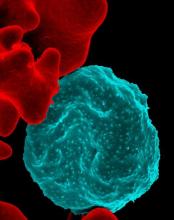User login
While the drug artesunate remains the gold standard for patients with severe Plasmodium falciparum malaria, it also can induce anemia within days or weeks of starting treatment.
In research published online in Science Translational Medicine, a team of researchers led by Papa Alioune Ndour, PhD, of the Université Paris Descartes, presented findings on how a cheap, widely available diagnostic test for malaria infection can be used, under a modified protocol, to predict a form of anemia known as postartesunate delayed hemolysis (PADH) (Sci Transl Med. 2017 Jul 5;9[397]. pii: eaaf9377).
Dr. Ndour and his colleagues discovered, studying prospective cohorts of 95 artesunate-treated malaria patients in Bangladesh and 53 in France, that, if they administered an HRP2 test on day 3 of treatment, a positive result predicted PADH with 89% sensitivity and 73% specificity. However, while the diagnostic test uses a whole blood sample, blood must be diluted 1:500 for the same test to predict PADH. The investigators also studied a comparison cohort of 49 quinine-treated patients in France, in whom HRP2 persistence was much lower.
Using the HRP2-based tests for PADH prediction is more complex than using it for malaria diagnosis, as blood samples must be diluted and because assessment “involves a quantitative element” to determine whether once-infected red blood cells have reached a concentration associated with a high risk of hemolysis, Dr. Ndour and his colleagues cautioned.
“Future large prospective studies will more precisely determine the robustness of prediction in different geographic and logistical settings,” the researchers wrote in their analysis.
The study was funded by the Bill & Melinda Gates Foundation, the French National Research Agency, and the Wellcome Trust. Five investigators, including Dr. Ndour, disclosed research grants from pharmaceutical firms for artesunate studies, two disclosed advisory board relationships with a Sigma Tau Laboratories, and another reported industry funding for anemia research related to artesunate.
While the drug artesunate remains the gold standard for patients with severe Plasmodium falciparum malaria, it also can induce anemia within days or weeks of starting treatment.
In research published online in Science Translational Medicine, a team of researchers led by Papa Alioune Ndour, PhD, of the Université Paris Descartes, presented findings on how a cheap, widely available diagnostic test for malaria infection can be used, under a modified protocol, to predict a form of anemia known as postartesunate delayed hemolysis (PADH) (Sci Transl Med. 2017 Jul 5;9[397]. pii: eaaf9377).
Dr. Ndour and his colleagues discovered, studying prospective cohorts of 95 artesunate-treated malaria patients in Bangladesh and 53 in France, that, if they administered an HRP2 test on day 3 of treatment, a positive result predicted PADH with 89% sensitivity and 73% specificity. However, while the diagnostic test uses a whole blood sample, blood must be diluted 1:500 for the same test to predict PADH. The investigators also studied a comparison cohort of 49 quinine-treated patients in France, in whom HRP2 persistence was much lower.
Using the HRP2-based tests for PADH prediction is more complex than using it for malaria diagnosis, as blood samples must be diluted and because assessment “involves a quantitative element” to determine whether once-infected red blood cells have reached a concentration associated with a high risk of hemolysis, Dr. Ndour and his colleagues cautioned.
“Future large prospective studies will more precisely determine the robustness of prediction in different geographic and logistical settings,” the researchers wrote in their analysis.
The study was funded by the Bill & Melinda Gates Foundation, the French National Research Agency, and the Wellcome Trust. Five investigators, including Dr. Ndour, disclosed research grants from pharmaceutical firms for artesunate studies, two disclosed advisory board relationships with a Sigma Tau Laboratories, and another reported industry funding for anemia research related to artesunate.
While the drug artesunate remains the gold standard for patients with severe Plasmodium falciparum malaria, it also can induce anemia within days or weeks of starting treatment.
In research published online in Science Translational Medicine, a team of researchers led by Papa Alioune Ndour, PhD, of the Université Paris Descartes, presented findings on how a cheap, widely available diagnostic test for malaria infection can be used, under a modified protocol, to predict a form of anemia known as postartesunate delayed hemolysis (PADH) (Sci Transl Med. 2017 Jul 5;9[397]. pii: eaaf9377).
Dr. Ndour and his colleagues discovered, studying prospective cohorts of 95 artesunate-treated malaria patients in Bangladesh and 53 in France, that, if they administered an HRP2 test on day 3 of treatment, a positive result predicted PADH with 89% sensitivity and 73% specificity. However, while the diagnostic test uses a whole blood sample, blood must be diluted 1:500 for the same test to predict PADH. The investigators also studied a comparison cohort of 49 quinine-treated patients in France, in whom HRP2 persistence was much lower.
Using the HRP2-based tests for PADH prediction is more complex than using it for malaria diagnosis, as blood samples must be diluted and because assessment “involves a quantitative element” to determine whether once-infected red blood cells have reached a concentration associated with a high risk of hemolysis, Dr. Ndour and his colleagues cautioned.
“Future large prospective studies will more precisely determine the robustness of prediction in different geographic and logistical settings,” the researchers wrote in their analysis.
The study was funded by the Bill & Melinda Gates Foundation, the French National Research Agency, and the Wellcome Trust. Five investigators, including Dr. Ndour, disclosed research grants from pharmaceutical firms for artesunate studies, two disclosed advisory board relationships with a Sigma Tau Laboratories, and another reported industry funding for anemia research related to artesunate.
FROM SCIENCE TRANSLATIONAL MEDICINE
Key clinical point:
Major finding: A positive result on an HRP2 test with diluted blood was 89% sensitive and 73% specific in predicting treatment-related anemia.
Data source: Two prospective cohorts of 95 artesunate-treated malaria patients in Bangladesh and 53 in France, plus a comparison cohort of 49 quinine-treated patients in France.
Disclosures: International foundations sponsored the study. Six of the investigators disclosed research support or other financial conflicts.


